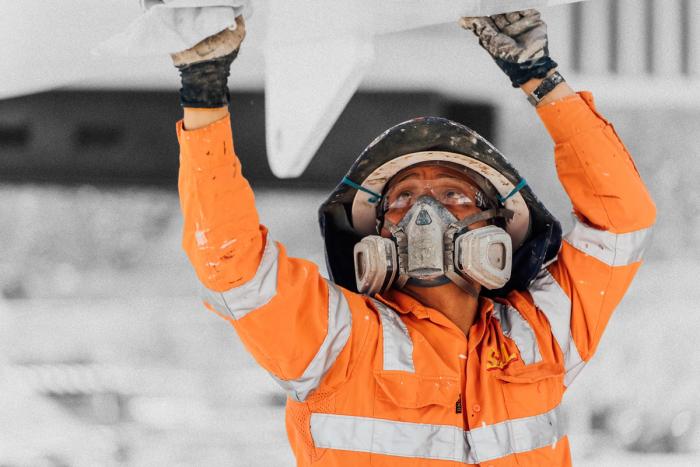Research Library
The MATES Research Library is a central hub for publications, evidence and insights that inform, evaluate and strengthen our approach to suicide prevention and mental health across our industries.
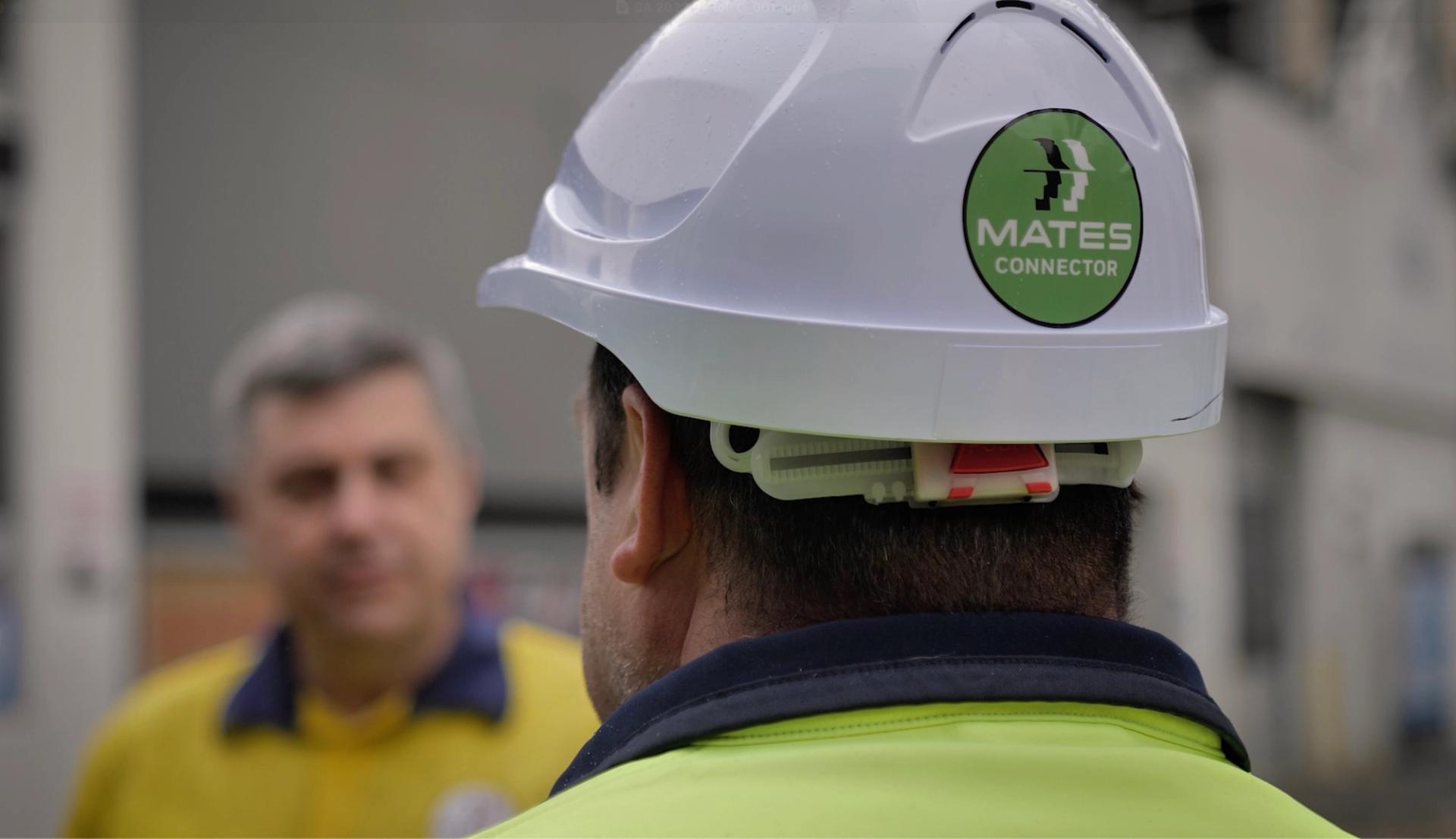
QLD / NT
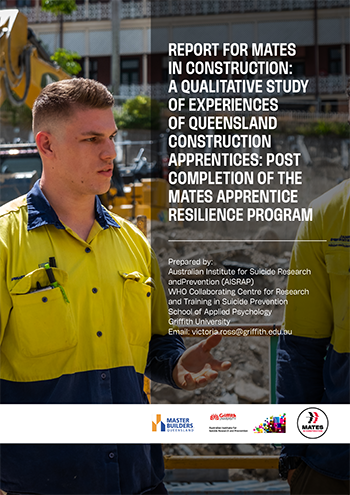
2024
Report for MATES in Construction: A Qualitative Study of Experiences of Queensland Construction Apprentices: Post Completion of the MATES Apprentice Resilience Program
Publisher:
AISRAP, School of Applied Psychology Griffith University
Authors:
V Ross, P Greacen
Overview:
A growing body of research has shown that young males working in the construction industry are at elevated risk of poor mental health and suicidality. In addition, a substantial portion of constructio...
A growing body of research has shown that young males working in the construction industry are at elevated risk of poor mental health and suicidality. In addition, a substantial portion of construction apprentices experience workplace bullying, which has been linked to psychological distress. In response to these findings, MATES in Construction developed a threefold training intervention program to address bullying, mental health and suicidality in construction industry apprentices. A recent quantitative evaluation program has shown strong evidence for their effectiveness.
QLD / NT
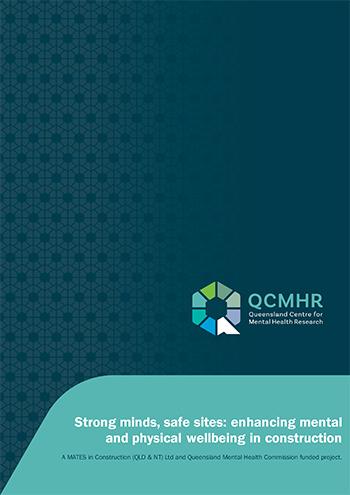
2024
Strong minds, safe sites: enhancing mental and physical wellbeing in construction
Publisher:
Queensland Centre for Mental Health Research
Authors:
C Meurk, L Wittenhagen, M Lam, C Doran, E Heffernan
Overview:
The Strong minds, safe sites: enhancing mental and physical wellbeing in construction report focuses on distress among Queensland construction industry workers, its drivers, impacts and opportunities ...
The Strong minds, safe sites: enhancing mental and physical wellbeing in construction report focuses on distress among Queensland construction industry workers, its drivers, impacts and opportunities for connection with support services. It highlights key findings from a study conducted by researchers from the Queensland Centre for Mental Health Research, in collaboration with construction industry organisations, which aims to improve systemic caring responses for people in the construction industry who experience distress.
NZ
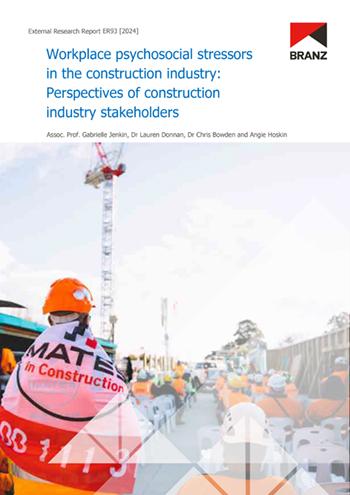
2024
Workplace Psychosocial Stressors in the Construction Industry: Perspectives of construction industry stakeholders (NZ)
Publisher:
BRANZ
Authors:
G Jenkin, L Donnan, C Bowden, A Hoskin
Overview:
Understanding the psychosocial stressors of an industry or workplace is vital for developing solutions to mitigate their adverse effects on mental health. This research provides a comprehensive explo...
Understanding the psychosocial stressors of an industry or workplace is vital for developing solutions to mitigate their adverse effects on mental health. This research provides a comprehensive exploration of the perceptions and experiences of stakeholders in the construction industry regarding psychosocial stressors, their mental health impacts, and possible solutions to help mitigate those impacts. The findings align with previous research, highlighting persistent issues in the construction industry. However, there is optimism as cultural change is evident, with increasing discussions on mental health and wellbeing in the sector.
NZ
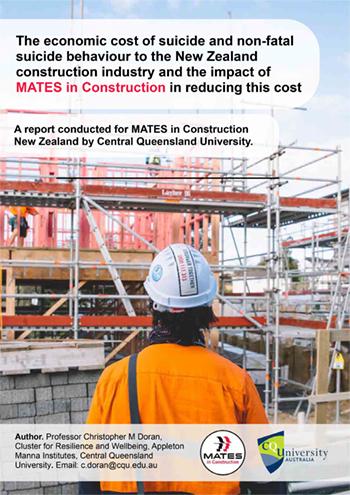
2024
The Economic Cost of Suicide and Non-Fatal Suicide Behaviour (NZ)
Publisher:
BRANZ
Authors:
G Jenkin, L Donnan, C Bowden, A Hoskin
Overview:
This study draws on empirical evidence and a validated costing methodology to provide a first attempt at the economic and social cost of suicide and non-fatal suicide behaviour to the NZ construction ...
This study draws on empirical evidence and a validated costing methodology to provide a first attempt at the economic and social cost of suicide and non-fatal suicide behaviour to the NZ construction industry and estimate the impact of MATES in Construction NZ (MATES) in reducing this cost. The MATES program effectively transforms the knowledge, attitudes, and behaviours of construction industry workers. This study conservatively estimates that the program saves at least one worker's life each year, generating $14.2 million in savings to society. The potential return on investment is equivalent to 1:4.42. For every $1 invested in MATES, a return of $4.42 is achieved.
QLD / NT
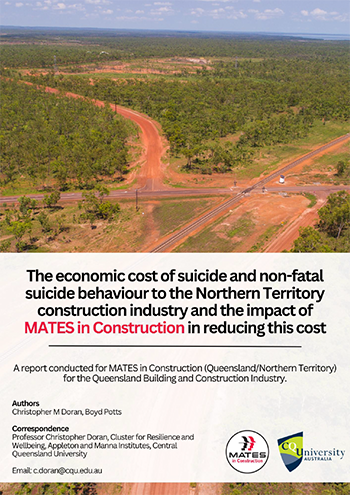
2024
The economic cost of suicide and non-fatal suicide behaviour to the Northern Territory construction industry and the impacts of MATES in Construction in reducing this cost
Publisher:
A report conducted for MATES in Construction (Queensland/Northern Territory) for the Queensland Building and Construction Industry.
Authors:
C Doran, B Potts
Overview:
This study draws on the empirical research and a validated costing methodology to quantify the economic cost of suicide and non-fatal suicide behaviour to the Northern Territory (NT) construction indu...
This study draws on the empirical research and a validated costing methodology to quantify the economic cost of suicide and non-fatal suicide behaviour to the Northern Territory (NT) construction industry and estimate the impact of MATES in Construction in reducing this cost.
NZ
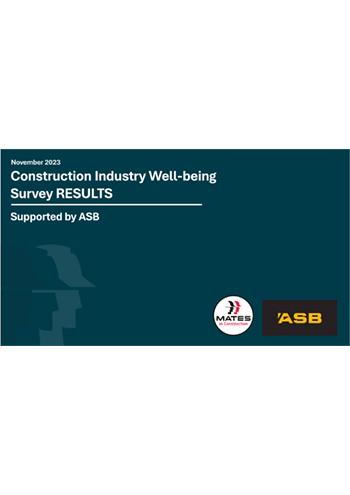
2024
Construction Industry Well-being Survey Results (NZ)
Publisher:
Supported by ASB
Authors:
MATES in Construction NZ
Overview:
The construction sector is a cornerstone of Aotearoa/New Zealand’s (NZ) economy, contributing NZ$17.6 billion and employing 10.7% of the national workforce as of mid-June 2023 (MBIE, 2024). Despite it...
The construction sector is a cornerstone of Aotearoa/New Zealand’s (NZ) economy, contributing NZ$17.6 billion and employing 10.7% of the national workforce as of mid-June 2023 (MBIE, 2024). Despite its economic significance and vibrant nature, the industry can present significant challenges to its workforce, negatively affecting their mental health, well-being, and ill-being* (Morrison, Tu, & Jenkin, 2022). Amidst these stressors, one of the most pressing issues facing the industry is its disproportionately high rate of suicide. Studies have revealed that construction workers experience some of the highest suicide rates across occupations in NZ, with an average of 1 worker lost to suicide every 5 days in 2023 (Jenkin & Atkinson, 2021; Ministry of Justice, 2024).
QLD / NT
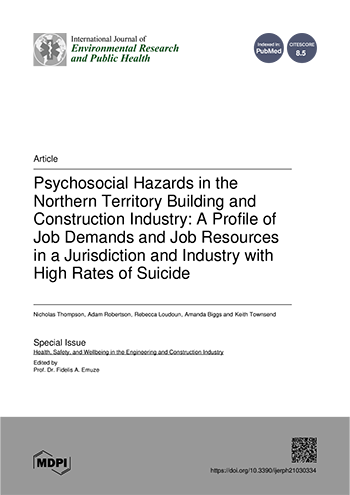
2024
Psychosocial Hazards in the Northern Territory Building and Construction Industry: A Profile of Job Demands and Job Resources in a Jurisdiction and Industry with High Rates of Suicide
Publisher:
International Journal of Environmental Research and Public Health
Authors:
N Thompson, A Robertson, R Loudoun, A Biggs, K Townsend
Overview:
The work environment for building workers in Australia’s Northern Territory (NT) is characterised by concerningly high rates of distress and suicide at both a jurisdictional and an industry level. Wor...
The work environment for building workers in Australia’s Northern Territory (NT) is characterised by concerningly high rates of distress and suicide at both a jurisdictional and an industry level. Work-related psychosocial hazards are known antecedents of work-related distress and suicide, and more research is required to understand how these hazards impact workers in this unique building context. This paper examines the unique work environment in the NT building industry by comparing psychosocial hazards in the NT with those in the broader Australian building and construction industry.
AUS
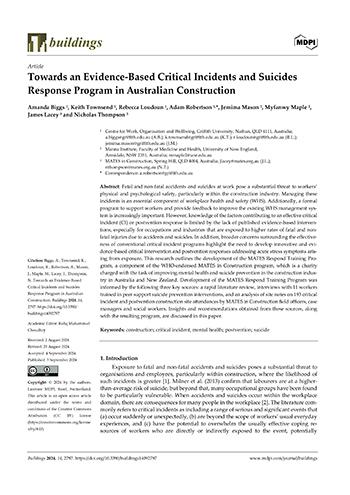
2024
Towards an Evidence-Based Critical Incidents and Suicides Response Program in Australian Construction
Publisher:
MDPI
Authors:
A Biggs, K Townsend, R Loudoun, A Robertson, J Mason, M Maple, J Lacey, N Thompson
Overview:
Fatal and non-fatal accidents and suicides at work pose a substantial threat to workers’ physical and psychological safety, particularly within the construction industry. Managing these incidents is a...
Fatal and non-fatal accidents and suicides at work pose a substantial threat to workers’ physical and psychological safety, particularly within the construction industry. Managing these incidents is an essential component of workplace health and safety (WHS). Additionally, a formal program to support workers and provide feedback to improve the existing WHS management system is increasingly important. Development of the MATES Respond Training Program was informed by the following three key sources: a rapid literature review, interviews with 11 workers trained in peer support suicide prevention interventions, and an analysis of site notes on 193 critical incident and postvention construction site attendances by MATES in Construction field officers, case managers and social workers.
AUS
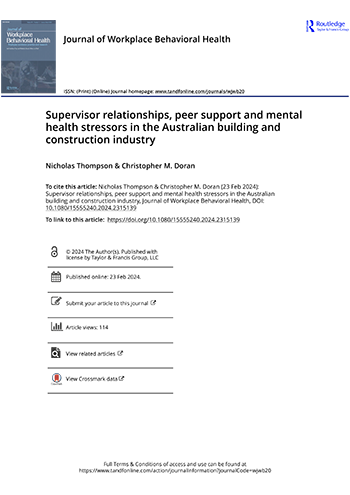
2024
Supervisor relationships, peer support and mental health stressors in the Australian building and construction industry
Publisher:
Routledge Taylor & Francis Group: JOURNAL OF WORKPLACE BEHAVIORAL HEALTH
Authors:
N Thompson and C Doran
Overview:
MATES operationalized a workplace mental health framework consisting of five domains in 2019 in a move toward a broader systems-based approach to workplace mental health in the building and constructi...
MATES operationalized a workplace mental health framework consisting of five domains in 2019 in a move toward a broader systems-based approach to workplace mental health in the building and construction work environment. Using job demands-resources (JD-R) theory and a revised ver-sion of the People at Work Survey (PAW-Con), the objective of this study is to explore workplace mental health trends within the Australian building and construction industry with the aim of identifying areas of improvement required to mitigate psychosocial hazards at work.
AUS
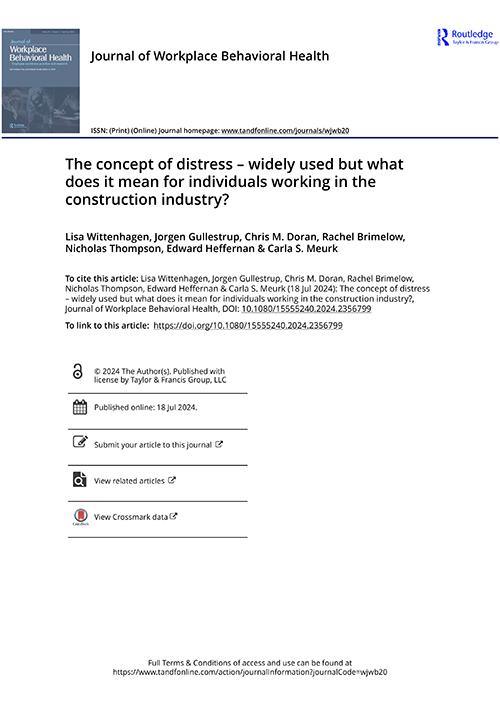
2024
The concept of distress – widely used but what does it mean for individuals working in the construction industry?
Publisher:
Journal of Workplace Behavioral Health
Authors:
L Wittenhagen, J Gullestrup, C Doran, R Brimelow, N Thompson, E Heffernan & C Meurk
Overview:
Distress is a frequently used concept, conveying a variety of meanings. Clear definitions are needed to promote common understanding, effective communication, and the development of solutions. One occ...
Distress is a frequently used concept, conveying a variety of meanings. Clear definitions are needed to promote common understanding, effective communication, and the development of solutions. One occupation in which workers disproportionately report distress is the construction industry. To implement effective models of care, a construction industry specific definition of distress is needed. Reducing distress may be explicitly achieved by offering appropriate coping strategies and actions for individuals to regain control and agency; however, a safe and supportive help-offering environment is a prerequisite for promoting help-seeking, and help-uptake behaviors.
